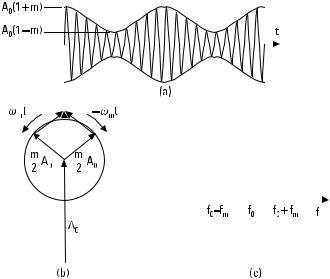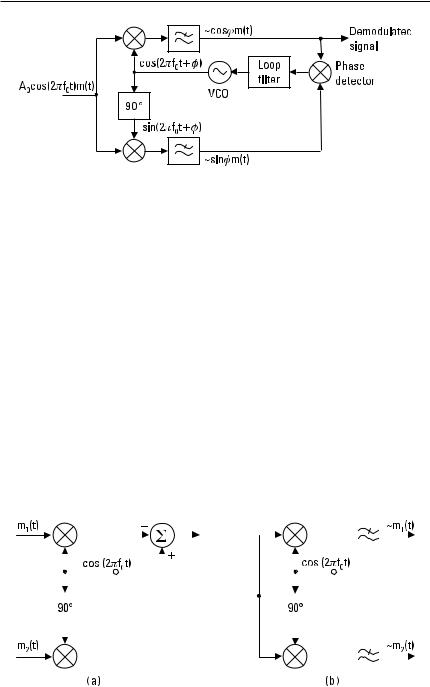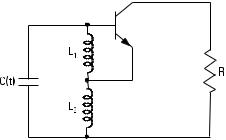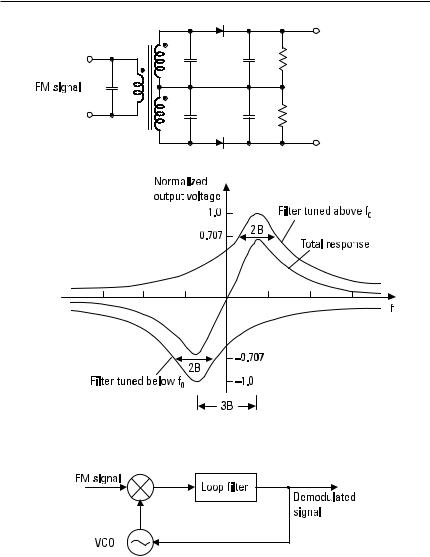
- •Radio Engineering for Wireless Communication and Sensor Applications
- •Contents
- •Preface
- •Acknowledgments
- •1 Introduction to Radio Waves and Radio Engineering
- •1.1 Radio Waves as a Part of the Electromagnetic Spectrum
- •1.2 What Is Radio Engineering?
- •1.3 Allocation of Radio Frequencies
- •1.4 History of Radio Engineering from Maxwell to the Present
- •2.2 Fields in Media
- •2.3 Boundary Conditions
- •2.4 Helmholtz Equation and Its Plane Wave Solution
- •2.5 Polarization of a Plane Wave
- •2.6 Reflection and Transmission at a Dielectric Interface
- •2.7 Energy and Power
- •3 Transmission Lines and Waveguides
- •3.1 Basic Equations for Transmission Lines and Waveguides
- •3.2 Transverse Electromagnetic Wave Modes
- •3.3 Transverse Electric and Transverse Magnetic Wave Modes
- •3.4 Rectangular Waveguide
- •3.4.1 TE Wave Modes in Rectangular Waveguide
- •3.4.2 TM Wave Modes in Rectangular Waveguide
- •3.5 Circular Waveguide
- •3.6 Optical Fiber
- •3.7 Coaxial Line
- •3.8 Microstrip Line
- •3.9 Wave and Signal Velocities
- •3.10 Transmission Line Model
- •4 Impedance Matching
- •4.1 Reflection from a Mismatched Load
- •4.2 Smith Chart
- •4.3 Matching Methods
- •4.3.1 Matching with Lumped Reactive Elements
- •4.3.4 Resistive Matching
- •5 Microwave Circuit Theory
- •5.1 Impedance and Admittance Matrices
- •5.2 Scattering Matrices
- •5.3 Signal Flow Graph, Transfer Function, and Gain
- •6.1 Power Dividers and Directional Couplers
- •6.1.1 Power Dividers
- •6.1.2 Coupling and Directivity of a Directional Coupler
- •6.1.3 Scattering Matrix of a Directional Coupler
- •6.1.4 Waveguide Directional Couplers
- •6.1.5 Microstrip Directional Couplers
- •6.2 Ferrite Devices
- •6.2.1 Properties of Ferrite Materials
- •6.2.2 Faraday Rotation
- •6.2.3 Isolators
- •6.2.4 Circulators
- •6.3 Other Passive Components and Devices
- •6.3.1 Terminations
- •6.3.2 Attenuators
- •6.3.3 Phase Shifters
- •6.3.4 Connectors and Adapters
- •7 Resonators and Filters
- •7.1 Resonators
- •7.1.1 Resonance Phenomenon
- •7.1.2 Quality Factor
- •7.1.3 Coupled Resonator
- •7.1.4 Transmission Line Section as a Resonator
- •7.1.5 Cavity Resonators
- •7.1.6 Dielectric Resonators
- •7.2 Filters
- •7.2.1 Insertion Loss Method
- •7.2.2 Design of Microwave Filters
- •7.2.3 Practical Microwave Filters
- •8 Circuits Based on Semiconductor Devices
- •8.1 From Electron Tubes to Semiconductor Devices
- •8.2 Important Semiconductor Devices
- •8.2.1 Diodes
- •8.2.2 Transistors
- •8.3 Oscillators
- •8.4 Amplifiers
- •8.4.2 Effect of Nonlinearities and Design of Power Amplifiers
- •8.4.3 Reflection Amplifiers
- •8.5.1 Mixers
- •8.5.2 Frequency Multipliers
- •8.6 Detectors
- •8.7 Monolithic Microwave Circuits
- •9 Antennas
- •9.1 Fundamental Concepts of Antennas
- •9.2 Calculation of Radiation from Antennas
- •9.3 Radiating Current Element
- •9.4 Dipole and Monopole Antennas
- •9.5 Other Wire Antennas
- •9.6 Radiation from Apertures
- •9.7 Horn Antennas
- •9.8 Reflector Antennas
- •9.9 Other Antennas
- •9.10 Antenna Arrays
- •9.11 Matching of Antennas
- •9.12 Link Between Two Antennas
- •10 Propagation of Radio Waves
- •10.1 Environment and Propagation Mechanisms
- •10.2 Tropospheric Attenuation
- •10.4 LOS Path
- •10.5 Reflection from Ground
- •10.6 Multipath Propagation in Cellular Mobile Radio Systems
- •10.7 Propagation Aided by Scattering: Scatter Link
- •10.8 Propagation via Ionosphere
- •11 Radio System
- •11.1 Transmitters and Receivers
- •11.2 Noise
- •11.2.1 Receiver Noise
- •11.2.2 Antenna Noise Temperature
- •11.3 Modulation and Demodulation of Signals
- •11.3.1 Analog Modulation
- •11.3.2 Digital Modulation
- •11.4 Radio Link Budget
- •12 Applications
- •12.1 Broadcasting
- •12.1.1 Broadcasting in Finland
- •12.1.2 Broadcasting Satellites
- •12.2 Radio Link Systems
- •12.2.1 Terrestrial Radio Links
- •12.2.2 Satellite Radio Links
- •12.3 Wireless Local Area Networks
- •12.4 Mobile Communication
- •12.5 Radionavigation
- •12.5.1 Hyperbolic Radionavigation Systems
- •12.5.2 Satellite Navigation Systems
- •12.5.3 Navigation Systems in Aviation
- •12.6 Radar
- •12.6.1 Pulse Radar
- •12.6.2 Doppler Radar
- •12.6.4 Surveillance and Tracking Radars
- •12.7 Remote Sensing
- •12.7.1 Radiometry
- •12.7.2 Total Power Radiometer and Dicke Radiometer
- •12.8 Radio Astronomy
- •12.8.1 Radio Telescopes and Receivers
- •12.8.2 Antenna Temperature of Radio Sources
- •12.8.3 Radio Sources in the Sky
- •12.9 Sensors for Industrial Applications
- •12.9.1 Transmission Sensors
- •12.9.2 Resonators
- •12.9.3 Reflection Sensors
- •12.9.4 Radar Sensors
- •12.9.5 Radiometer Sensors
- •12.9.6 Imaging Sensors
- •12.10 Power Applications
- •12.11 Medical Applications
- •12.11.1 Thermography
- •12.11.2 Diathermy
- •12.11.3 Hyperthermia
- •12.12 Electronic Warfare
- •List of Acronyms
- •About the Authors
- •Index
Radio System |
287 |
At frequencies that do not penetrate the ionosphere, that is, in the HF band and at lower frequencies, noise from electric discharge in the atmosphere (lightning) is dominant. The amount depends on the season and day, location, and frequency.
Noise from space dominates at frequencies from 20 MHz to 1 GHz. The Milky Way produces RF noise, which is at its maximum in the plane of the Milky Way and decreases as the direction goes away from this plane. The Milky Way noise also decreases as frequency increases. At all frequencies there is a 3K cosmic background radiation, which has its origin in the Big Bang, that is, it is a remnant of the birth of the universe.
Thermal noise due to the atmospheric attenuation is the dominating noise source above 1 GHz. It depends on the atmospheric humidity and elevation angle. The atmosphere can be considered as an attenuator at a physical temperature of about 270K.
Noise due to human activity may be considerable, especially near densely populated areas. In the VHF band and at lower frequencies, noise from the spark plugs of cars and power lines may be stronger than that from nature.
11.3 Modulation and Demodulation of Signals
Information to be transmitted in a radio system, such as voice or music, is first transformed to a low frequency, for example, an audio frequency, electric signal. This baseband signal cannot be directly transmitted through a radio channel, or at least that would be very inefficient. The signal is first fed into a modulator, which modulates some property (amplitude, frequency, phase) of a high-frequency carrier according to the baseband signal. The highfrequency signal obtained is then transmitted by a transmitting antenna. A receiving antenna receives the high-frequency signal and feeds it into a receiver. In the receiver the signal is often downconverted to an intermediate frequency and then demodulated, that is, the original baseband signal is detected; for example, in the case of voice radio, the original voice signal is recovered. In other words, with a modulator the information is attached into a carrier, and with a demodulator it is detached.
There are a number of different modulation schemes, which can be divided into analog and digital methods. Modulation is important not only in communication (radio broadcasting, radio links, mobile phone systems) but also in radar, radionavigation, and so on. Modulation is treated in many communication textbooks, for example, [8–10].

288 Radio Engineering for Wireless Communication and Sensor Applications
11.3.1 Analog Modulation
A sinusoidal waveform can be presented as
A (t ) = A 0 cos (v 0 t + c0 ) = A 0 cos (2p f 0 t + c0 ) |
(11.27) |
Information can be attached into this carrier by modulating one of its basic properties according to the baseband signal. Modulation methods are:
1.Amplitude modulation (AM): Information is attached to the carrier amplitude.
2.Frequency modulation (FM): Information is attached to the carrier frequency.
3.Phase modulation (PM): Information is attached to the carrier phase.
AM is in principle the simplest method, but it has high requirements, especially for the linearity of the transmitter. It is used in radio broadcasting in the LF, MF, and HF bands, and in TV broadcasting. FM is used, for example, in FM radio.
11.3.1.1 AM
Let us consider a signal that is amplitude modulated by a sinusoidal signal at frequency f m :
A (t ) = A 0 [1 + m cos (2pf m t )] cos 2pf 0 t |
(11.28) |
Thus, the amplitude varies between values of A 0 (1 − m ) and A 0 (1 + m ). Factor m is the modulation index or modulation depth. The signal envelope follows the modulating signal as shown in Figure 11.9(a), if m < 1. The carrier frequency should be much higher than the modulating frequency. Equation (11.28) can be presented as
A (t ) = A 0 Fcos v 0 t + m2 cos (v 0 + vm ) t + m2 cos (v0 − vm ) tG (11.29)
The graphical interpretation of this equation is presented in Figure 11.9(b). A constant voltage phasor A 0 corresponds to the carrier frequency. Two voltage phasors with an amplitude of (m /2) A 0 rotate in opposite

|
|
|
|
|
|
|
|
Radio System |
289 |
|||||
|
|
|
|
|
|
|
|
|
|
|
|
|
|
|
|
|
|
|
|
|
|
|
|
|
|
|
|
|
|
|
|
|
|
|
|
|
|
|
|
|
|
|
|
|
|
|
|
|
|
|
|
|
|
|
|
|
|
|
|
|
|
|
|
|
|
|
|
|
|
|
|
|
|
|
|
|
|
|
|
|
|
|
|
|
|
|
|
|
|
|
|
|
|
|
|
|
|
|
|
|
|
|
|
|
Figure 11.9 Amplitude-modulated signal: (a) in time domain; (b) phasor presentation; and
(c) frequency spectrum.
directions at an angular frequency of vm . The resultant of these three voltage phasors gives the total voltage. The spectrum contains the components at frequencies f 0 , f 0 + f m , and f 0 − f m , as shown in Figure 11.9(c).
If the modulating baseband signal is more complicated, it can be considered as consisting of several sinusoidal components, which have a given amplitude and phase. The modulating signal has a given spectrum and each spectral component modulates the carrier independently.
Figure 11.10 presents the spectrum of an AM signal when the modulating signal is distributed over a given frequency range. The AM is using lavishly both the power and frequency spectrum, because also the carrier not containing information is transmitted and one sideband is only a mirror image of the other. Transmitter power can be saved using DSB modulation, in which the carrier is suppressed, that is, it is not transmitted. This modulation scheme is also called double-sideband suppressed carrier (DSBSC) modulation. The frequency spectrum is saved by removing the other sideband, which leads to SSB modulation.
If the modulating signal contains frequency components near the zero frequency, use of SSB modulation becomes complicated, because it is difficult to separate the sidebands. Vestigial sideband (VSB) modulation is a compromise between SSB and DSB modulations. In VSB, one sideband is trans-

290 Radio Engineering for Wireless Communication and Sensor Applications
Figure 11.10 Spectra of basic AM, DSB, and SSB modulation.
mitted nearly in full, but only a small part of the other sideband is transmitted, as illustrated in Figure 11.11. VSB can be realized more easily than SSB by filtering from DSB.
11.3.1.2 Amplitude Modulators and Demodulators
A mixer can be used as an amplitude modulator. The modulating waveform is fed into the IF port and the carrier into the LO port, and the modulated signal is obtained from the RF (signal) port, as in Figure 11.12. In a doublebalanced mixer there is a good isolation between the LO and RF ports. In that case the carrier is suppressed, and a DSB signal is obtained. The SSB modulation can be realized using the circuit shown in Figure 11.13.
Figure 11.11 VSB modulation.
Figure 11.12 A mixer as an amplitude modulator.

|
|
|
|
|
|
|
Radio System |
291 |
||||||||
|
|
|
|
|
|
|
|
|
|
|
|
|
|
|
|
|
|
|
|
|
|
|
|
|
|
|
|
|
|
|
|
|
|
|
|
|
|
|
|
|
|
|
|
|
|
|
|
|
|
|
|
|
|
|
|
|
|
|
|
|
|
|
|
|
|
|
|
|
|
|
|
|
|
|
|
|
|
|
|
|
|
|
|
|
|
|
|
|
|
|
|
|
|
|
|
|
|
|
|
|
|
|
|
|
|
|
|
|
|
|
|
|
|
|
|
|
|
|
|
|
|
|
|
|
|
|
|
|
|
|
|
|
|
|
|
|
|
|
|
|
|
|
|
|
|
|
|
|
|
|
|
|
|
|
|
|
|
|
|
|
|
|
|
|
|
|
|
|
|
|
|
|
|
|
|
|
|
|
|
|
|
|
|
|
|
|
Figure 11.13 An SSB modulator.
An AM signal can be demodulated by an envelope detector. The output of an envelope detector follows the envelope of the input signal, as shown in Figure 11.14. During one half forward cycle the capacitance C is charged rapidly to the peak voltage value of the signal. The time constant R S C must be much shorter than the cycle length 1/f 0 . In the reverse direction the capacitor C discharges slowly, but it has to be able to follow the modulating signal. This leads to a condition 1/f 0 << R L C << 1/B, where B is the bandwidth of the modulating signal.
In order to demodulate a DSB signal, the carrier must be generated in the receiver. Both the frequency and phase must be correct. The DSB demodulator shown in Figure 11.15 is called the Costas loop, and it resembles the PLL. The input signal is mixed with orthogonal LO signals from a VCO. The difference signals selected by the lowpass filters are proportional to m (t ) cos f and m (t ) sin f, where f is the phase error of the LO. The third mixer produces a signal that adjusts the VCO phase and frequency until the output signal of the upper branch is at maximum and that of the lower branch vanishes. Also, demodulation of an SSB signal requires generation
Figure 11.14 An envelope detector as an amplitude demodulator.

292 Radio Engineering for Wireless Communication and Sensor Applications
Figure 11.15 A DSB demodulator.
of the carrier. In order to aid this process, a pilot carrier may be transmitted together with the sideband.
11.3.1.3 Quadrature AM (QAM)
QAM is a modulation method that combines two orthogonal DSB signals into the same band. In the transmitter shown in Figure 11.16(a), the phase difference between the two carriers is 90°. In the receiver there is also a 90° phase difference between the two LO signals, and the original baseband signals can be separated. QAM is used in TV broadcasting.
11.3.1.4 FM
The amplitude of a frequency-modulated signal is constant, and the instantaneous frequency varies according to the modulating signal. If the modulating signal is sinusoidal, the instantaneous frequency is
|
|
|
f (t ) = |
1 |
|
df (t ) |
= f 0 + D f cos (2p f m t ) |
(11.30) |
|||||||||||||||
|
|
2p |
|
dt |
|
||||||||||||||||||
|
|
|
|
|
|
|
|
|
|
|
|
|
|
|
|
|
|
||||||
|
|
|
|
|
|
|
|
|
|
|
|
|
|
|
|
|
|
|
|
|
|
|
|
|
|
|
|
|
|
|
|
|
|
|
|
|
|
|
|
|
|
|
|
|
|
|
|
|
|
|
|
|
|
|
|
|
|
|
|
|
|
|
|
|
|
|
|
|
|
|
|
|
|
|
|
|
|
|
|
|
|
|
|
|
|
|
|
|
|
|
|
|
|
|
|
|
|
|
|
|
|
|
|
|
|
|
|
|
|
|
|
|
|
|
|
|
|
|
|
|
|
|
|
|
|
|
|
|
|
|
|
|
|
|
|
|
|
|
|
|
|
|
|
|
|
|
|
|
|
|
|
|
|
|
|
|
|
|
|
|
|
|
|
|
|
|
|
|
|
|
|
|
|
|
|
|
|
|
|
|
|
|
|
|
|
|
|
|
|
|
|
|
|
|
|
|
|
|
|
|
|
|
|
|
|
|
|
|
|
|
|
|
|
|
|
|
|
|
|
|
|
|
|
|
|
|
|
|
|
|
|
|
|
|
|
|
|
|
|
|
|
|
|
|
|
|
|
|
|
|
|
|
|
|
|
|
|
|
|
|
|
|
|
|
|
|
|
|
|
|
|
|
|
|
|
|
|
|
|
|
|
|
|
|
|
|
|
Figure 11.16 QAM: (a) transmitter and (b) receiver.

Radio System |
293 |
where Df is the maximum frequency deviation. The equation for an FM signal waveform is
|
F |
|
f m |
|
G |
A (t ) = A 0 cos f (t ) = A 0 cos |
|
2p f 0 t + |
Df |
sin (2p f m t ) |
|
|
|
|
(11.31)
The spectrum of the FM signal contains, besides the carrier, an infinite number of sidebands with a separation of f m . The required bandwidth is wider than that in AM, but tolerance to noise and interference is better. The amplitudes of the carrier and sidebands depend on the modulation index m = Df /f m . The amplitude A sp of a sideband p relative to the amplitude A 0 of an unmodulated carrier is obtained from
A sp |
|
= Jp (D f /f m ) |
(11.32) |
|
A 0 (m = 0) |
||||
|
|
|||
where Jp is the p th order Bessel function of the first kind. Figure 11.17 presents Bessel functions and Figure 11.18 shows an FM power spectrum when the modulation index is m = 5.52. In this case the normalized amplitude J0 of the carrier component is small.
If m is small—less than unity—there is in the spectrum only one important sideband on both sides of the carrier, and A s1 /A 0 ≈ m /2. The
Figure 11.17 Bessel functions (first kind).

294 Radio Engineering for Wireless Communication and Sensor Applications
Figure 11.18 Spectrum of a frequency-modulated signal when the modulation index is m = 5.52.
spectrum looks like the AM spectrum, but the phases of the sidebands are different.
In theory the FM signal requires an infinite bandwidth. If we allow a given maximum distortion, we can limit the bandwidth. According to Carson’s rule the required bandwidth is [10]
B ≈ 2D f + 2f m = 2Df (1 + 1/m ) = 2f m (1 + m ) |
(11.33) |
11.3.1.5 Frequency Modulators and Demodulators
FM can be realized with a VCO. The output frequency of some oscillators can be controlled directly by changing the operation point of the nonlinear element. In other VCOs the frequency is controlled by voltage tuning the resonance frequency of the high-Q embedding circuit, which contains a voltage-dependent element such as a varactor.
Figure 11.19 shows a Hartley oscillator. The input network contains a varactor. The resonance frequency of the input resonator is
f = |
|
|
1 |
(11.34) |
|
|
|
||
|
2p √(L 1 |
+ L 2 ) C (t ) |
||
Let us assume that C changes sinusoidally an amount of DC around C0 and that the ratio DC /C 0 is small. Then

Radio System |
295 |
Figure 11.19 A Hartley oscillator.
f = |
|
|
|
|
1 |
|
|
|
|
|
|
||||
|
|
|
|
|
|
|
|
|
|
|
|
|
|
||
2p√(L 1 + L 2 ) (C0 |
+ DC cos 2pf m t ) |
||||||||||||||
|
|||||||||||||||
= |
|
|
|
|
1 |
|
|
|
|
|
1 |
|
|
(11.35) |
|
|
|
|
|
|
|
|
|
|
|
|
|
||||
|
2p√(L 1 + L 2 ) C0 |
√1 + |
(DC /C0 ) cos 2pf m t |
||||||||||||
|
|
S |
|
|
2C0 |
|
|
D |
|
|
|
|
|||
≈ f 0 |
|
1 − |
DC |
cos 2p f m t |
|
|
|
|
|
||||||
|
|
|
|
|
|
|
|||||||||
= f 0 |
+ D f cos 2p f m t |
|
|
|
|
|
|
|
|||||||
which shows that we have a frequency modulator.
A frequency demodulator produces a voltage, the instantaneous value of which is proportional to the instantaneous frequency of the signal. Networks capable of doing so include, for example, a frequency discriminator, such as the one shown in Figure 11.20, and a PLL, shown in Figure 11.21. In the frequency discriminator there are two resonance circuits, each followed by an envelope detector. One resonance circuit is tuned to a frequency above the carrier frequency, the other one below. One detector produces a positive output voltage, the other one a negative output voltage. The sum of these voltages is linear in the vicinity of the carrier frequency, if the difference between the resonance frequencies has a proper value. Usually there is an amplitude limiter before the frequency discriminator to eliminate the effects of signal amplitude variations. In the PLL, the control voltage of the VCO contains the demodulated signal, if the frequency depends linearly on the control voltage.
11.3.1.6 PM
PM is closely linked to FM because frequency f (t ) is obtained from the derivative of phase f(t ) = v(t ) t + c(t ) and accordingly the phase is obtained as an integral of the frequency:

296 Radio Engineering for Wireless Communication and Sensor Applications
Figure 11.20 FM demodulator based on a frequency discriminator and its normalized output voltage.
Figure 11.21 A PLL as an FM demodulator.
f (t ) = |
1 df(t ) |
(11.36) |
||||
|
|
|
|
|||
2p dt |
||||||
|
|
|||||
f(t ) = 2p Et |
f (t ′) dt ′ + f(0) |
(11.37) |
||||
0
